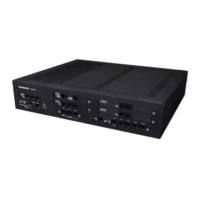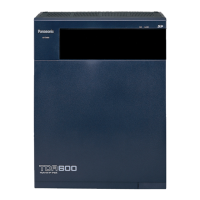Item One-look Network H.323 QSIG Network
PBX relationship Master–Slave Independent
Programming and
configuration
Unified: Settings made on the
Master unit are automatically
propagated to Slave units.
Independent: Each PBX in the
network must be programmed
individually.
Maximum number of
nodes
16 (1 Master, 15 Slaves) 512
Minimum system
requirements
One KX-NSN001 (Activation
Key for
One-look Network) per PBX
One V-IPGW card per PBX
*1
*1
For non-KX-NS1000
PBXs, requirements may differ.
When to choose a One-look network
If the network will consist only of KX-NS series PBXs and a private IP network is feasible, then a One-look
network is probably the better option. A considerable amount of setup is done automatically by the PBXs, so
setup and maintenance is much simpler. All units can be programmed from one location. This simple setup
and programming means that the PBX network can be expanded with considerably less effort.
Extensions are managed so they behave as if they were all connected to one PBX, which eliminates the need
to manage information such as PBX access codes.
However, resource sharing also requires a lot of bandwidth, since the Master unit must constantly monitor and
manage the status of the Slave units and connected devices. Therefore, if bandwidth is a concern, an H.323
QSIG network may be preferable.
When to choose an H.323 QSIG network
If the network will include non-KX-NS series PBXs (e.g., KX-TDE200, KX-NCP500), then an H.323 QSIG
network is necessary.
An H.323 QSIG network is preferable if strict resource separation between sites is necessary. Although it is
possible to reserve certain resources for certain extension users in a One-look network, the default is to share
resources. On the other hand, in a QSIG network, resources are not available to extension users of other PBXs
without explicit programming.
Programming and configuring an H.323 QSIG network is much more complex than a One-look network.
It is also possible to connect a One-look network to other PBXs via QSIG. In an H.323 QSIG network, the
One-look network appears as one PBX. The Master unit represents the One-look network.
Installation Manual References
8.4.1 One-look Network
8.4.4 H.323 QSIG Network
8.4.5 Working with Multiple PBX Networks
Feature Manual References
15.1.12 PRIVATE NETWORK FEATURES
15.1.23 Private Network Features—VoIP (Voice over Internet Protocol)
246 Feature Manual Document Version 2016-03
14.1.5 One-look Network—IP Network Type Comparison

